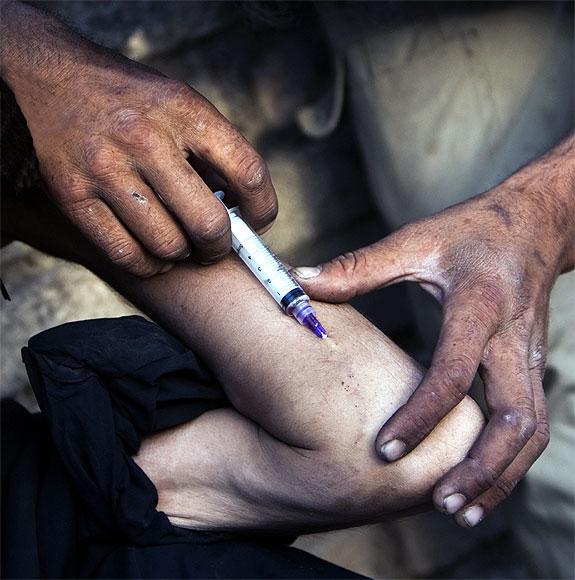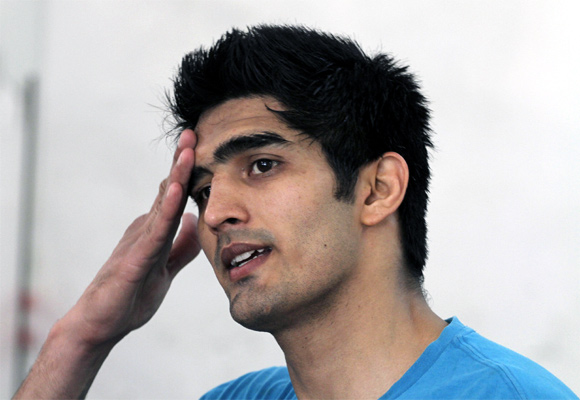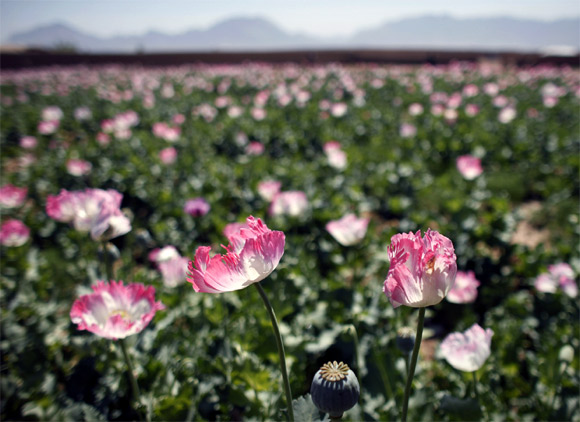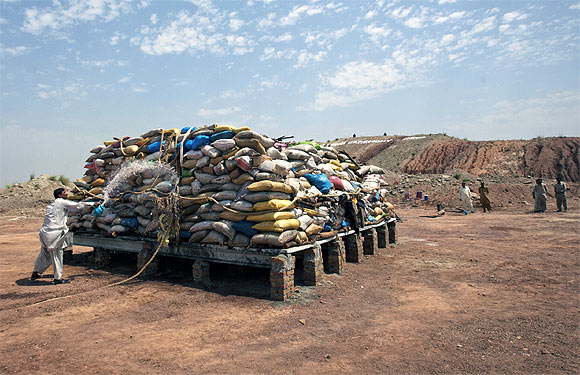Photographs: Reuters
From traditional heroin and cocaine to over-the-counter medicines, drugs hang heavy over Punjab's future with 70 per cent of youth believed to be affected by the problem. Aabhas Sharma travels across the state to find out how the government is tackling the menace.
"Four years of my life have been ruined and I don't even know if I have a future," a 21-year-old college student says as he walks out of the Post Graduate Institute of Medical and Research in Chandigarh. Here at PGIMER, he has been coming to the drug de-addiction centre for six-months now and tells of his struggle with drug abuse and rehabilitation. He got addicted to drugs of all kinds -- mainly heroin, ganja, opium -- when he came to Chandigarh in 2008 to "escape" his father's farming business.
At first, things were going according to plan. The first year of college saw him perform well, but he soon started mingling with the quintessential rich Punjabi mundas. SUVs, farmhouse parties, alcohol and drugs gave him and his friends a high like they had never experienced before. Almost six months into a de-addiction programme, the highs have turned into lows but he is glad that his family is supporting him in rehabilitation.
If the numbers are anything to go by, this is a familiar story in rural and urban Punjab. According to several independent studies and surveys, more than 70 percent of the state's population in the 15-35 age group has problems related to drugs. Studies have revealed that drug users in Punjab start as early as 13. In the past three months, Punjab police have seized drugs worth over Rs 500 crore. A household survey conducted by the UN's International Classification of Diseases indicates that over 60 per cent of families in the Doaba, Malwa and Majha regions of Punjab have at least one addict. In 2010-11, Punjab had accounted for 60 per cent of the total drugs seized in India. Over 7,000 patients undergo treatment in various drug de-addiction centres every year in the state.
These numbers paint a grave picture, one that is getting more serious by the day.
"It's a huge problem," acknowledges Vini Mahajan, principal secretary, department of health and family welfare, Punjab. Mahajan says that there are no official figures about the addicts but the figures doing the rounds are "more or less accurate."
Click on NEXT for more...
Punjab chokes under a chemical cloud
Image: Vijender SinghPhotographs: Reuters
When Congress Vice President Rahul Gandhi said at an election rally in Punjab that seven of every ten youth in Punjab were addicted to drugs, there was a furore and Akali Dal and Bharatiya Janata Party leaders termed his remarks as "untrue."
But Gandhi wasn't way off the mark, and even the state government agrees that the magnitude of the problem is immense. In Punjab, drugs have cut through the caste and class barrier as well. The rich are high on heroin and cocaine while the poor pop pills or inject drugs to get a high.
About 30 kg of heroin was confiscated from Anoop Singh Kahlon, a close friend and boxing partner of Olympic medallist, Vijender Singh.
You name a drug and its usage is rampant in Punjab, but mainly it is heroin in various forms that is most commonly abused. Cities like Amritsar, Jalandhar, Ferozepur and Gurdaspur are the hub of heroin, cocaine and smack, while Ludhiana, Kapurthala, Moga wrestle with synthetic drugs.
Most addicts start with "bhukki", a form of wild weed which grows freely on the fields of Punjab.
One of the key reasons for this enormous social problem is, as Mahajan points out, the easy availability of drugs. Heroin packets are often hurled across the border from Pakistan into bordering villages. Border areas are heavily manned by the Border Security Force, yet drugs are smuggled in copious amounts every year in the state.
In 2009, former Narcotics Control Bureau officer Saji Mohan was arrested on charges of pilfering heroin in the state.
Click on NEXT for more...
Punjab chokes under a chemical cloud
Image: A large field of poppies grows on the outskirts of Jelawar village in Arghandab Valley, AfghanistanPhotographs: Reuters
Punjab has been a transit point for drug smuggling from Afghanistan via Pakistan, but never before have the drugs actually stayed in Punjab, says a BSF official. "In the last few years, cross-border civilian movement has increased in Punjab and drugs are easily smuggled in," he says.
For instance, heroin was found in cement bags on a train coming from Pakistan in October 2012, but the easiest way to bring in drugs still remains human carriers. BSF officials say that they've caught women carrying 50 kg of heroin stitched into their clothes.
The drug trail goes something like this: from Afghanistan, heroin is bought at Rs 1 lakh per kg and through Pakistan it is smuggled into Punjab and sold for about Rs 30 lakh per kg. From Punjab it reaches various parts of the country and is sold at approximately Rs 1 crore per kg. A gram of heroin can be procured at Rs 1,000, while a gram of smack costs Rs 300.
The peddlers find ready customers in the unemployed youth of the state. Unemployment or, more pertinently, as Mahajan puts it, "lack of desired employment", is a growing worry in Punjab.
Farming, the mainstay of Punjabi families for ages, no longer attracts the young. Those who can afford it, migrate to countries like UK and Canada. The ones who remain back in villages are lured by the big cities of Amritsar, Chandigarh or Ludhiana. Once they reach there, they aren't qualified enough to do skilled jobs. Frustration sets in. An easy way out of depression is drugs.
Prisons in Punjab are another problem area. About 62 per cent of inmates are addicts, says an NCB report. But Mahajan says that steps are being taken to tackle the issue. Eight model jails in Punjab now have trained medical officers who deal with addiction problem. "We plan to implement this programme in other state jails as well," she adds.
Click on NEXT for more...
Punjab chokes under a chemical cloud
Image: Farming, the mainstay of Punjabi families for ages, no longer attracts the youngPhotographs: Reuters
While the government has commissioned studies -- none of them have been published so far -- one man who has spent six years researching the drug epidemic is Ravindra Singh Sandhu, professor of sociology at Guru Nanak Dev University in Amritsar. Sandhu conducted his study on 600 addicts in the four main districts of Amritsar, Jalandhar, Patiala and Bathinda and found that the number of drug addicts in the state had grown alarmingly fast.
"It's scary how an entire generation is getting hooked on to all kinds of substances," he says.
Drugs like heroin and smack aren't the only problem in the state -- a large number of people get their daily fix from medicine shops. Cough syrups like Corex, Phensedyl or tablets like Proxyvon and Diazepam are easily available over-the-counter, and at the de-addiction centres doctors note increasing addiction to these common medications.
"Many medicine stores are surviving on this activity alone. There are villages where you will be hard-pressed to find a hospital but there will be at least a dozen medicine shops," says Brij Bedi, a social activist.
People often say that two things open early in Punjab -- liquor shops and medicine shops. Drive around Punjab's villages and you will see medicine shops with shutters open as early as 6 am, says Sandhu. "When I visited villages near Patiala, I saw a cluster of medicine shops where people queued up to get their supply of drugs," he says.
Youngsters inject drugs like Coaxil directly into the bloodstream. It is common to see used syringes in gutters and drains in villages of Punjab. The IDUs, or intravenous drug users, in Punjab count among the highest for any state in India.
Click on NEXT for more...
Punjab chokes under a chemical cloud
Image: A member of Pakistan's Anti-Narcotics Force pours gasoline on a pile of confiscated drugs before setting it ablazePhotographs: Reuters
Mahajan admits that the number of medicine stores in the state is a big problem, forcing the government to be more stringent about new applications for licences. "We are doing a thorough check on anyone who applies for a licence now," she says.
Mahajan says that Punjab Deputy Chief Minister Sukhbir Singh Badal is personally keeping track of the problem. In the last two years, the government has spent around Rs 350 crore to tackle the problem.
"This money has been spent on training doctors, improving the de-addiction centres as well as research," she says.
There are around 50 government-recognised drug rehabilitation centres in Punjab, which currently treat over 7,000 patients. According to Debashish Basu, professor, PGIMER, there has been a rise in the number of patients at the institute's drug de-addiction centre. Around 1,000 patients come there in a year, but not all of them are from Punjab. Some come from Haryana, Jammu and Kashmir and Himachal Pradesh as well.
There are numerous private centres as well but these aren't equipped to handle drug cases. There have been reports of patients being chained and beaten up on the pretext of "disciplining" them. There have been advertisements in newspapers by de-addiction centres claiming use of laser treatment to cure drug addiction.
"Most of the centres don't have the skilled manpower to handle the problem but are riding on the wave," says Basu.
Doctors are of the opinion that most addicts don't survive because of the lack of family support. Khatam (finished) is a word that reverberates in de-addiction centres.
"A drug addict cannot survive nor overcome the problem without family support. These addicts are shunned by all, made social outcasts and, rather than getting help, they get sucked into the problem deeper," says Basu.
The government, on its part, is aware of the drug menace and Mahajan says that it is committed to eradicating the evil. Social activists and sociologists, however, feel that if serious steps aren't taken in the next few years to deal with the issue, a large portion of Punjab's youth will be addicted to drugs by 2030.
Click on NEXT for more...







article